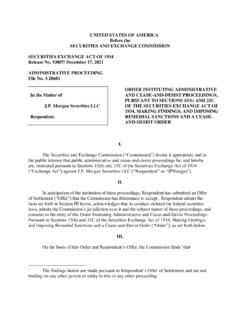Transcription of HHS PPDR Selected Dispute Resolution Entities
1 1 Guidance for Selected Dispute Resolution (SDR) Entities : Required Steps to Making a Payment Determination under the Patient-Provider Dispute Resolution (PPDR) Process Information and Background .. 2 Background .. 2 Applicability .. 3 4 the Patient-Provider Dispute Resolution Process .. 6 Timeframe .. 6 Delivery of the Initiation Notice .. 6 Notice Content .. 6 Process Following Initiation: Selection of the SDR Entity .. 7 Timeframe .. 7 Selected SDR Entity Responsibilities After Selection.
2 7 Validation of Initiation Notice .. 8 Notice of Selected Dispute Resolution Entity Selected by HHS .. 8 to Provider or Facility .. 9 Information Needed from the Provider or Facility .. 9 Manner of Submission .. 10 5. Extension of time Periods for Extenuating 10 Determination .. 11 Timeframe .. 11 Payment Determination .. 11 For an Item or Service that Appears on the Good Faith Estimate: .. 11 For an Item or Service that does not Appear on the Good Faith Estimate (new item or service).
3 12 Calculation of the Final Payment Amount .. 13 Written Payment Determination .. 13 Effects of Determination .. 13 and Reporting Requirements .. 13 Process Administrative Fee .. 14 DEPARTMENT OF HEALTH AND HUMAN SERVICES _____ 2 Administrative Fee .. 14 Failure to Pay the Administrative Fee .. 15 Requirements .. 15 Privacy .. 15 Security .. 15 Breach and Incident Notification .. 16 Timing, Form, and Manner of Breach Notification .. 17 Appendix A Definitions .. 19 Appendix B State-Federal Interaction.
4 22 Appendix C Summary of the Patient-Provider Dispute Resolution (PPDR) Process .. 23 Appendix D Other 25 1. General Information and Background Effective January 1, 2022, the No Surprises Act1 (NSA) protects uninsured (or self-pay) individuals from many unexpectedly high medical bills. Providers and facilities will be required to furnish a good faith estimate of expected charges after an item or service is scheduled, or upon request. Throughout this document the term providers also includes providers of air ambulance services.
5 The good faith estimate will include an enumerated list of items and services, grouped by each provider or facility, reasonably expected to be provided for the primary item or service, and items and services reasonably expected to be furnished in conjunction with the primary item or service, for that peri od of care. Additionally, a new patient-provider Dispute Resolution (PPDR) process will be available for uninsured (or self-pay) individuals who get a bill for an item or service that is substantially in excess of the expected charges on the good faith estimate.
6 Under the PPDR process, an uninsured (or self-pay) individual, or their authorized representative2, may initiate the PPDR process for a determination about how much to pay a provider or facility for specific items or services. This process can provide important consumer protections for the uninsured (or self-pay) individual from billed charges that are substantially in excess of the expected charges in the good faith estimate. An uninsured (or self-pay) individual is an individual who does not have health insurance benefits for an item or service under a group health plan, group or individual health insurance coverage offered by a health insurance issuer, federal health care program (as defined in section 1128B(f) of the Social Security Act), or a health benefits plan under chapter 89 of title 5, United States Code.
7 Or an individual who has benefits for an item or service under a group health plan or individual or 1 Enacted as part of the Consolidated Appropriations Act, 2021 (Pub. L. 116-260). 2 Authorized representative means an individual authorized under State law to provide consent on behalf of the uninsured (or self-pay) individual, provided that the individual is not a provider affiliated with a facility or an employee of a provider or facility represented 3 group health insurance coverage offered by a health insurance issuer, or a health benefits plan under chapter 89 of title 5, United States Code, but does not seek to have a claim for such item or service submitted to such plan or coverage.
8 On October 7, 2021, HHS published in the Federal Register interim final rules (IFRs) titled Requirements Related to Surprise Billing; Part II,3 implementing various provisions of the NSA, including good faith estimates and the PPDR process for payment determinations. Applicability The requirements for health care providers and health care facilities related to the issuance of good faith estimates of expected charges for uninsured (or self-pay) individuals (or their authorized representatives), upon request or upon scheduling an item or service under 45 CFR are generally applicable for good faith estimates requested on or after January 1, 2022 or for good faith estimates required to be provided in connection with items or services scheduled on or after January 1, 2022.
9 HHS recognizes that some providers or facilities may need to establish efficient and secure communication channels for transmission of good faith estimate information between convening providers or facilities and co-providers and co-facilities. A convening health care provider or convening health care facility is the provider or facility who receives the initial request for a good faith estimate from an uninsured (or self-pay) individual and who is or, in the case of a request, would be responsible for scheduling the primary item or service.
10 A co-provider or co-facility is a provider or facility that furnishes items or services that are customarily provided in conjunction with a primary item or service. It is also understood that it may take time for providers and facilities to develop systems and processes for receiving and providing the required information from co-providers and co-facilities. Therefore, for good faith estimates provided to uninsured (or self-pay) individuals from January 1, 2022 through December 31, 2022, HHS will exercise its enforcement discretion in situations where a good faith estimate provided to an uninsured (or self-pay) individual does not include expected charges from co-providers or co-facilities.













